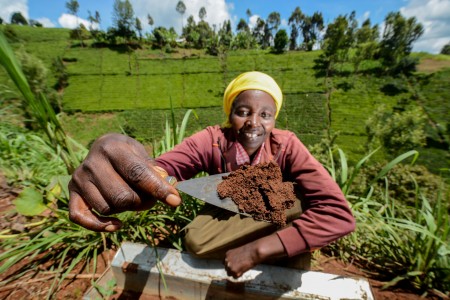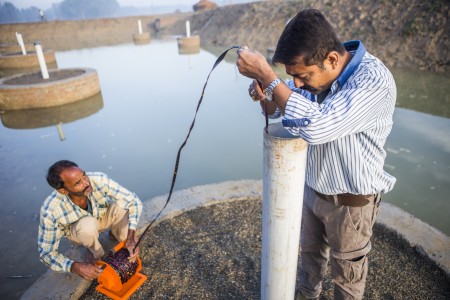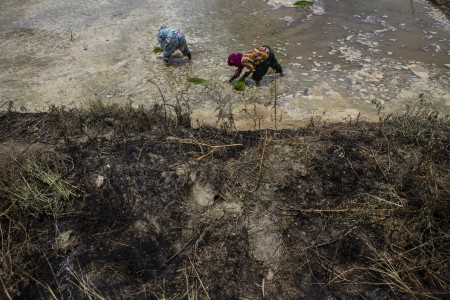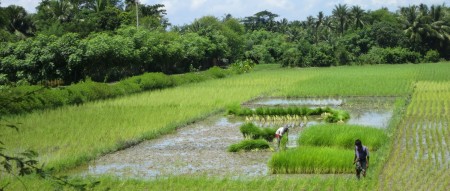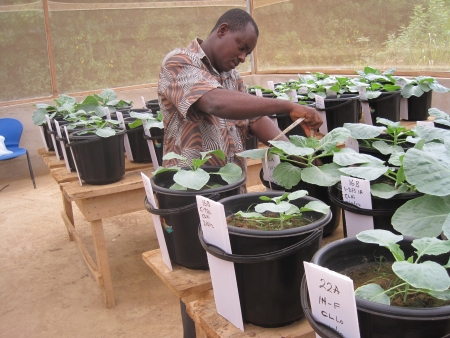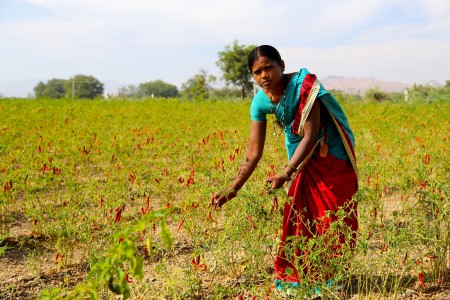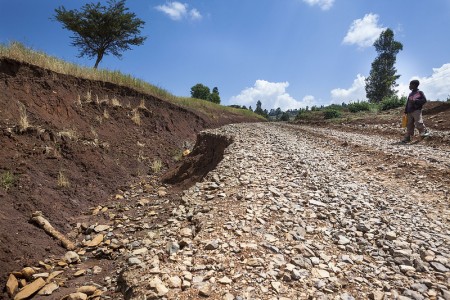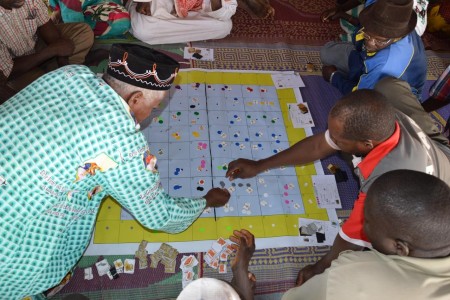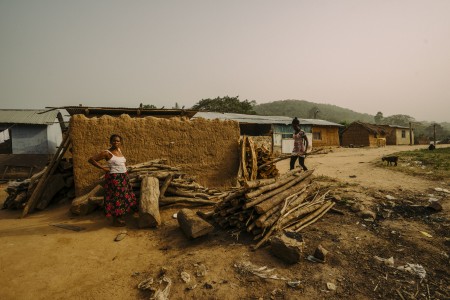The WLE 2016 Annual Report > Facilitating community-led science

Soil and water conservation measures for halting and reversing land degradation
In the highlands of northwest Ethiopia, farmers are simultaneously dealing with land degradation and vulnerability to climate change. These threats to their livelihoods and food security are inextricably linked, so it makes sense that they require holistic solutions that also help to ensure the sustainability of the ecosystems on which these farmers rely.
Land degradation in the Ethiopian highlands is predominantly evidenced by extensive soil erosion. While deforestation is often locally cited as the major cause, the picture is much more complex.
WLE, through the International Center for Agricultural Research in the Dry Areas (ICARDA) and the International Water Management Institute (IWMI), has been working to provide practical solutions focusing on soil and water conservation (SWC). SWC practices include soil fertility and crop management, soil erosion control measures and water harvesting, all good ways to address the challenges faced in the Amhara region of northwest Ethiopia.
Modelling land use change to prepare for climate variation
Through ICARDA, WLE has used hydrological and bio-economic models to assess the impact of climate and land use change on watershed management. As part of this work WLE has also been specifically exploring strategies to improve women’s livelihoods as a way to simultaneously enhance equity and strengthen agricultural productivity. Like many farmers in Africa, these communities combine crop farming with livestock rearing and other income generating activities in a patchwork of efforts to meet their needs.
Farmers' perceptions about their vulnerability to climate variability were explored through participatory research processes. This gave WLE the opportunity to sound out farmer's willingness to adopt improved soil and water management options, some of which may have been new to them.
Remote sensing identified land use changes over time showing, for example, that between 1986 and 2007, around 30% of watershed forests were lost, much of them replaced with crops. Hydrological and bio-economic models, developed and calibrated using extensive datasets and combined with downscaled climate change scenarios, are being used to analyze system dynamics, productivity and constraints at the watershed scale. Findings from this research are included in a book, Mitigating Land Degradation and Improving Livelihoods.
Establishing exclosures to improve watershed rehabilitation
Also in the Amhara region of Ethiopia, WLE, through IWMI, has been exploring the impacts of exclosures in the Gomit watershed. Exclosures are plots of land that have been closed off to protect against interference from people and domestic animals, allowing a process of soil and vegetation rehabilitation. In the Gomit watershed, exclosures were identified and established in close collaboration with local communities and are managed by the Community Watershed Team together with the Regional Bureau of Agriculture, the District Agricultural and Rural Development Offices, and other district administrative bodies.
11 exclosures were established on communal grazing land, anywhere from 1 to 7 years ago. Community members and researchers have all noticed a regeneration of indigenous tree species, increased vegetation cover, reduced soil erosion and water channel sedimentation, increased fodder production and the rehabilitation of gullies. Additionally, exclosures offer further benefits that could lead to revenue generation from carbon trading.
WLE's work has resulted in a catalogue of management options examining exclosures for ecosystem restoration and economic benefits in Ethiopia. WLE has also produced guidance on sustaining the benefits of soil and water conservation in the highlands of Ethiopia and on expanding and sustaining exclosure land management. These form parts of a set of identified methods for sustaining soil and water conservation in Ethiopia.
Data and tools to improve management of land and water
WLE also developed a tool that offers a participatory, user-friendly and gender-sensitive approach to evaluating land management options from the perspectives of farmers themselves; the Evaluating Land Management Options (ELMO) tool.
In collaboration with local communities, strengthening local capacity and facilitating collective action, WLE is making a significant contribution to addressing the challenges of land degradation and vulnerability to climate change faced by farmers in the Ethiopian Highlands. The tools and approaches developed by WLE researchers, as well as the exploration of a diverse range of land and water management options, have the potential to increase rural incomes and reduce food insecurity in tandem with enhancing environmental sustainability. Through these processes, WLE and others are learning valuable lessons that may also be usefully applied in other parts of Africa and beyond.
Towards sustainable intensification:
stories of real-world sciencewater, land and ecosystems research highlights
Phase 1
Since its inception in 2012, the CGIAR Research Program on Water, Land and Ecosystem (WLE) has developed scientific evidence and solutions for sustainably intensifying agriculture.
For WLE, sustainable intensification means more than minimizing agriculture’s environmental footprint; it means making sure that agriculture benefits both the planet and its people, providing global populations with food and nutritional security, resilience and livelihoods.
WLE researchers and their partners work across scales, disciplines and sectors to find sustainable, viable ways to transform agriculture, locally and at scale. Discover how the resulting solutions can lead to real-world change by exploring the briefs and stories below to.
New briefs on sustainable intensification
Achieving resilient food systems requires identifying incentives for sustainable farming, developing new policies and institutions, as well as working with diverse stakeholders to test and scale integrated solutions.
The program’s findings so far are summarized in a new series of briefs, Towards sustainable intensification: Insights and solutions.
The series aims to guide and support decision and policy makers, investors and others working to achieve sustainable intensification of agriculture. Each brief is focused on a topic of strategic relevance and provides analysis of and recommendations on how to place sustainability at the heart of agri-food systems.
in 2015 wle: field tested 62 technologies and natural resource management practices, helped 125,000 farmers to apply new technologies or management practices, supported improved technologies or management practices on 2.5 million hectares
Influencing policy and decision making
In 2015 WLE: established 41 multi-stakeholder platforms and influenced 200 policy processes
Promoting innovative business models and institutions
Facilitating community-led science
WLE in 2015 had 110,000 website visits and 43,000 views on CG-space and published 141 ISI publications and 94 open access publications




